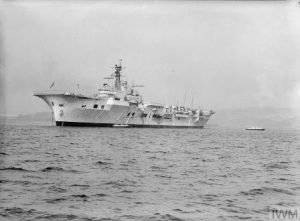The Township of Laugharne sits in a peaceful location in a valley at the outlet of the Rivers Tâf and Corran, with its estuary guarded by the ruins of a Norman castle. The men of Laugharne who fell in both World Wars are commemorated on two separate Memorials in St. Martins Church and also on a relatively new memorial sited outside the newly rebuilt Memorial Hall, in Clifton Street, which contain the same names. For some reason these Memorials omit several local men, who I have taken the liberty to add on these pages. Due to the large numbers of photographs involved I have had to split the Laugharne WW1 and WW2 memorials onto two separate pages. This page commemorates those men of Laugharne who fell during World War Two.
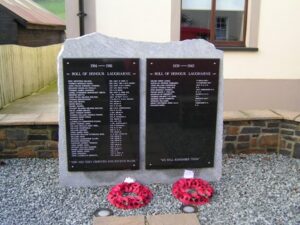
World War Two, 1939-1945
John William Congreve, Lieutenant, Royal Navy. John was born on 12 August 1912, the son of Major Claude Vyvian Congreve, of the Indian Army, and Mary Hudson Congreve (nee Titley), of Island House. The family originally bore the surname Schneider, until the advent of WW1 when Claude changed it to Congreve. John enrolled into the RNVR (London Division) on 22 January 1937. He was promoted to T/S/ Lieutenant on 28 September 1939 and posted to HMS Rhodora, an armed yacht. On 15 August 1940 John was made a full Lieutenant and posted to the destroyer HMS Tynedale, a newly built ‘Hunt’ class destroyer. Tynedale took part in ‘Operation Chariot’ on the on the night of 28 March 1942. Operation Chariot was an ambitious plan hatched by the British Combined Operations to disable the Normandie dry dock at St. Nazaire on the French coast. HMS Tynedale was part of the escort to the old American destroyer HMS Campbelltown, which was used to smash into the gates of the massive dry docks, and was exploded there-putting the dock out of action for the rest of the war-and thus prevented the Germans from bringing their massive Battleship, the Tirpitz into the port. She was escorting a convoy off the coast of Algeria on 12 December 1943 when she was spotted and torpedoed by the German submarine U-593. John died that day, as a result of the torpedo explosion, at the age of 31. He is remembered on the Plymouth Naval Memorial, Devon.
Thomas Lewis Ebsworth, Captain, Welsh Regiment. Thomas was born in Pendine, the son of John Stephen Ebsworth and Mary Elizabeth Ebsworth of the Beach Hotel. At the outbreak of the Great War, Thomas enlisted into the Welsh Regiment. He was soon promoted to Sergeant, and in 1916 Thomas was posted to the Officer Training Corps, Ayrshire. He was commissioned into the 6th Welsh on 19 December 1916. The battalion was the Pioneer Battalion to the 1st Division. Thomas saw much action during the Great War, which saw him being awarded the Croix-de-Guerre by the French Government. He returned back to Wales and set up home in Fullerton House, Laugharne. Thomas settled back into civilian life well. Along with his brother John, he became a partner in the firm of Ebsworth Brothers, at Clifton Garage. He took an active role in the Township, becoming the Vice President of the regatta committee, a member of the War Comforts and Welcome Home Committee; Chairman of the Billiard and Social Club, as well as a Foreman of the Jury in Laugharne Corporation. Upon the outbreak of WW2, Thomas re-enlisted, and raised the local Home Guard. He enrolled over 100 men, and was appointed Company Commander of ‘E’ Company, Carmarthenshire Home Guard. On 23 December 1941, Thomas’ wife, Rose Emily, passed away at their home aged 50. The stress of losing his wife, coupled with his efforts to raise the local Home Guard, took its toll on Thomas’ health, and on Sunday 1 February 1942, after a short illness, Thomas died at his home, Fullerton House. The couple were survived by their son, Tommy, but sadly Tommy died on 30 July 1942, aged just 20. On the Thursday following his death, Thomas was laid to rest at St. Martins Church, Laugharne. Thomas is not commemorated on the Laugharne Memorial, or even by the CWGC.

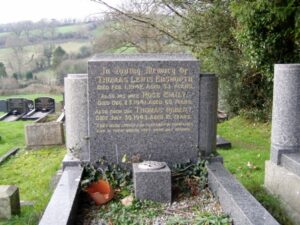
Douglas George Edmunds, Private, 3963251, Hampshire Regiment. Douglas was born at Halldown Farm, Laugharne in 1917, the son of Thomas Rees and Mary Jane Edmunds. The family later moved to Hendy, near Pontardulais. Douglas married before the war, and lived at Hendy with his wife, before enlisting into the Army, and joining the 5th Battalion, Hampshire Regiment. The Battalion was part of the allied army that landed at Sicily between 9 and 12 July 1943. They invaded Italy on 3 September and mounted an amphibious assault at Salerno on 8 September 1943. The objective of the Italian campaign was to draw German troops away from the Russian front, and especially from the French coast, where the offensive was planned for the following year. Douglas was killed during the battle at Salerno on 9 September 1943, and is buried in the Salerno War Cemetery, Italy.
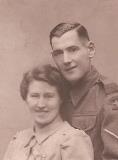
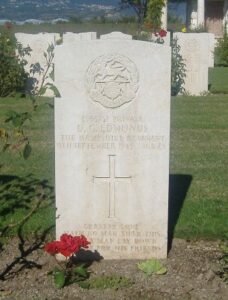
Emrys Evans, Pilot Officer, 119172, Royal Air Force Volunteer Reserve. Emrys was born in Whitland, the son of Gwilym Evans, a railway worker from Laugharne, and his wife Anne Evans. By 1911 the family was living at 31, Fron Terrace, Llanelli. Emrys had graduated from University with a B.Sc. from the Welsh Board of Education and had begun teaching at Whitland Grammar School before enlisting into the Royal Air Force Volunteer Reserve, joining 156 Squadron as an Air Gunner. 156 Squadron was formed at Alconbury in 1942 as a medium bomber squadron, flying the Vickers Wellington Mark III, and operated with No. 3 Group. Emrys was commissioned into the Squadron from Flight Sergeant on 21 March, 1942. On 30 May, 1942 a massive raid was launched by Bomber Command on Cologne. 1,047 aircraft took to the sky, amongst them was the Wellington X3598 in which Emrys served, under the command of Pilot Officer Bain D.F.C. 898 aircraft managed to drop their deadly cargoes on the city, causing terrible fires, before turning around and heading for home. Emrys and his crew were intercepted and shot down over Holland on the return journey, at 00.35 on the morning of 31 May 1942. Emrys and his five other crew-mates died in the crash, aged 25 and is buried at Bergen-Op-Zoom War Cemetery.
William John Healy, Private, 3956610, Welch Regiment. William was born in Laugharne in 1910, the son of William Reuben Healy and Hannah Ann Healy (nee Rowlands). He spent his early years living with his grandparents, Thomas and Maria Rowlands, at Frog Street, Laugharne, as his father was working as a Mason’s Labourer at Caerau. The family later moved to Blue Street, Carmarthen and after leaving school, William found work as a labourer. He married Mary Kezia Thomas, of Mill Street, Carmarthen at Christ Church on 23 April 1932. William enlisted into the Welch Regiment, and served throughout the war. He survived the conflict, but died as a result of his service in hospital at Leominster on 25 August 1946. The remains of the 35-year-old were brought home and he was buried in Carmarthen Cemetery. William is not commemorated at Laugharne.
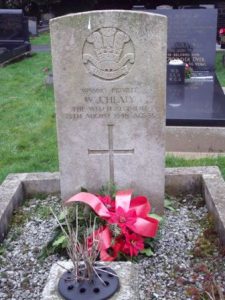
Charles Aidan Vernon Jefferys, First Officer, 968927, Air Transport Auxiliary. Charles was born at Tetbury, Gloucestershire on 30 August 1910, the son of Reverend Charles Thomas Claude Jefferys and Eva Jefferys (nee Pride). His father had been born in Laugharne in 1880, the son of Charles and Adeline Jefferys, of King Street, but had left the township after becoming a Vicar. Charles was educated at St Pauls School before becoming an engineer at Newport and on 8 December 1934 married Mary Gertrude Burton in Stroud. He enlisted into the Royal Air Force Volunteer Reserve soon after the outbreak of war and trained as a pilot on a variety of aircraft, including the Tiger Moth, Miles Magister, Lysander, Airspeed Oxford, Bristol Blenheim, and the Vickers Wellington. Charles was then deemed as being more suitable to be a ferry pilot and was attached to the Air Transport Auxiliary, delivering aircraft to various RAF bases around the country. On 10 March 1944 Charles took off from RAF Aldergrove, flying a Vickers Wellington II, Serial W5385, which he was to deliver to RAF Shawbury, in Shropshire. The aircraft failed to gain height and crashed into the ground soon after take-off, killing Charles on impact. The 33-year-old was buried in Stroud New Cemetery, Gloucestershire. His widow, Mary, later married Irvin Miller and migrated to America after the war. Charles is not commemorated on the Laugharne War Memorial.

Henry Brynmor John, MBE, Lieutenant-Commander (S), Royal Navy. Henry was the son of Jonah and Mary John, and was born in 1897 in High Street, Narberth. Henry had married Elizabeth Dorothy Williams, who was the daughter of Mr. and Mrs. John F. Williams of Laugharne. Henry was educated at Narberth School, and during 1914, at the age of 17, he entered into St. George’s College in London to pursue a Naval Career. By the age of 18, Henry was serving in the Royal Navy aboard HMS Juno, where he assisted with the rescue of survivors from the torpedoed passenger ship ‘Lusitania’, which had been sunk by a German submarine off the Irish coast with great loss of life. By 1920, Henry had been awarded the Order of the Nile, whilst serving at the Royal Naval base at Port Said and had reached the rank of Paymaster-Lieutenant. Later that year Henry was awarded the MBE and was invested by King George V at Buckingham Palace. By the age of 38, Henry had risen to the rank of Paymaster Commander. Henry’s first posting after the Great War was aboard the cruiser HMS Frobisher. On 14 November 1930, he was posted to Bermuda (HMS Flora). Henry spent a year aboard the battleship HMS Rodney, until July 1935, and then transferred to the cruiser HMS Exeter where he saw active service during the famous ‘Sinking of the Graf Spee’ off the River Plate in South America. From 15 November 1941, Henry served aboard the Battleship HMS Resolution, as Squadron Accountant, 3rd Battle Squadron. On 29 December 1943, Henry was transferred to the navigation school at Portsmouth (HMS Dryad). He was promoted to Commander in the Royal Navy, and served on the Combined Operations staff under Lord Mountbatten, which planned the D-Day landings. Henry’s last posting was at HMS President, a Royal Naval Gunnery School in London. It was whilst serving there that Henry and his wife decided to visit Plymouth en-route to a trip home to visit family in Narberth and Laugharne. Whilst in Plymouth, Henry took ill and was taken into St. George’s Hospital in London. He died three weeks later of heart failure, aged 49, on 26 August 1946, and was cremated in the Golders Green Crematorium, Middlesex. He had been a Burgess of Laugharne and also a Vice-President of the ‘Laugharne Sports and Attractions.’ Henry left behind his wife Elizabeth, his brother, Lieutenant-Commander Roy John, and two sisters, Mrs J. Evans Williams of Llanelli and Miss Elvie John of Narberth.
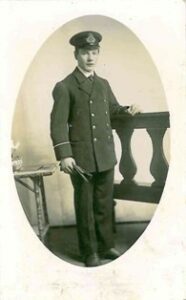
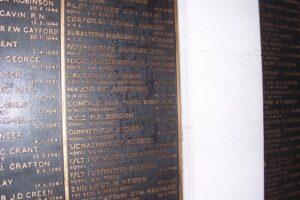
Thomas William Saint John, Gunner, 1089358, Royal Artillery. Thomas was born on 18 October 1910, the son of Thomas John and Mary Sarah John (nee Jones), of Avon Bank, St. Clears. He had played rugby for Laugharne, before leaving for London to become a bank clerk and after marrying Dorothy Martha Rawles on 26 February 1938, the couple settled at 27, Cresta Court, Hanger Hill, Ealing, London. Thomas enlisted into the Royal Artillery soon after the outbreak of war and was posted to the Far East, joining the 118th Field Regiment, Royal Artillery, which formed part of the Singapore Garrison. The Regiment was in Singapore at the time of the Japanese attack on 8 February 1942, as part of 18th Division. After a week of heavy fighting, the Garrison surrendered to the Japanese on 15 February 1942. The survivors of the Battle for Singapore were interned in the infamous Changi Jail. From here, the men were shipped to various parts of the Far East to be used as labourers by their Japanese captors. Thomas was among 900 British Prisoners of War who boarded the Japanese ‘Hell ship’ Kachidoki Maru on 6 September 1944 at Singapore. Six days into her voyage to Japan, the convoy containing the Kachidoki Maru was spotted by a patrol of three American Submarines in the South China Sea. The Americans opened fire; The USS Sealion sank the Rakuyo Maru with over 1,300 POW’s aboard, while the submarine USS Pampanito fired a spread of torpedoes into the helpless Kachidoki Maru, with 900 POW’s aboard. After realising what they had done, the Americans surfaced and began to pull survivors out of the water, but over 380 British and Australian POW’s were lost in the sinking. Thomas, who was 34 years old, was amongst those who died in the sinking on 12 September 1944. He has no known grave but the sea, so is commemorated on the Singapore Memorial, Kranji. Thomas is also commemorated on his parents headstone in Laugharne Churchyard.
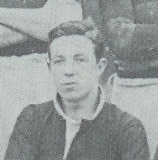
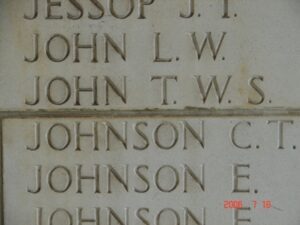
Charles Glynn Jones, Sergeant, 413083, Royal New Zealand Air Force. Charles was born in New Zealand on 22 July 1922, the son of Oscar Hugh Jones and Phyllis Gertrude Jones (nee Thomas). His father had been born in Victoria House, Laugharne in 1895, but had emigrated to New Zealand with his parents as a young man. Charles enlisted into the Royal New Zealand Air Force and trained as a pilot, before being posted to England, and joined 15 (Pilots) Advanced Flying Unit, at RAF Leconfield, Yorkshire. The unit specialised in acclimatising pilots from the Empire in the different conditions that they would face in Europe, before they were posted to operational squadrons. Charles was already an experienced pilot when he arrived in England, so his training was purely to get him up to speed for duties over occupied Europe. During the early hours of 9 September 1942, Charles took off from RAF Leconfield aboard an Airspeed Oxford, Serial BG270, together with his instructor, Sergeant Mitchell of the RAF, but the aircraft failed to climb away and crashed a few minutes later into rising ground, bursting into flames on impact. Charles and his instructor were both killed in the crash. Charles was 20 years old when he was killed that morning and is buried in Brigg Cemetery, Lincolnshire. He is not commemorated on the Laugharne war memorial.
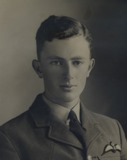
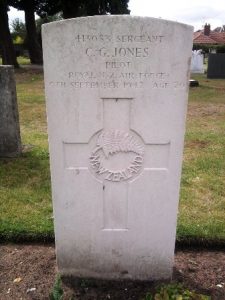
Daniel Delme Owen Lewis, Private, 3963252, Welch Regiment. Delme was born in Laugharne on 29 April 1920, the son of David and Beatrice May Lewis of Bronwast Farm. Against his father’s wishes, Delme enlisted into the Territorial Army around 1937, along with many of his friends from Laugharne. At the outbreak of War the Territorials were called up, and Delme joined the 1st Battalion, Welch Regiment, joining the battalion in Palestine. The battalion then moved to the Western Desert, arriving at Mersa Matruh during November 1939. Before they had a chance to take on the Italians in North Africa, they were sent to Alexandria and when the threat to the British refuelling bases at Crete became serious, were sent to reinforce the garrison on the island. On 14 May 1941, the German onslaught against Crete began. The island was saturation bombed by 600 Luftwaffe aircraft, softening up the British defences before the German airborne assault was launched. Waves of Junkers 52 troop carrier aircraft and gliders brought German paratroopers to the battle, and by pouring in reinforcements the Germans were virtually in control of the island within a week. The last stand for the 1st Welch in Crete came on 28 May, when nine German battalions overwhelmed them. Some 300 survivors reached the British naval base at Sphakia, where they were evacuated to Alexandria. Here the remnants of the 1st Welch were to face the might of the German Afrika Korps. Now rebuilt to full strength, the 1st Welch were involved in the fierce struggle to hold Benghazi throughout January 1942, but were ordered to withdraw to the Egyptian frontier. The Welch battalions had been split into individual companies during the withdrawal, and met with vastly differing levels of success-many were wiped out by the Germans. Of the 700 odd officers and men of the 1st Welch who fought at Benghazi, only 214 survived. The survivors of the battalion were sent to Khartoum, where it refitted and was brought back up to strength and then was sent to Palestine to train for the invasion of Italy. Letters from the International Red Cross Archives show that Daniel was captured on 11 February 1942 by the Italian Army at Tobruk. The Red Cross have records of a telegram sent to them by the Italian Authorities on 19 February 1942 stating that Delme was a Prisoner of War of the Italians, and that upon being shipped from North Africa back to Italy, along with hundreds of other Allied POW’s, the steamer that they were on was torpedoed and sank, probably by a British submarine. Delme is today commemorated on the Alamein War Memorial, Libya.

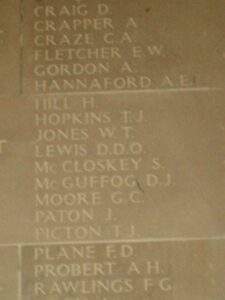
Henry Douglas McDermott, Major, Royal Army Ordnance Corps. Henry was born at Gosport, Hampshire in 1899, the son of Commander Thomas and Mrs. Frances McDermott, later of Laugharne. On 29 May 1915 Henry enlisted into the 2nd Portsmouth Battalion, Royal Marines. He was discharged to a Commission into the Army a month later, and served in France for the remainder of the Great War. After the war Henry returned to Laugharne, with his wife Eliza McDermott, and the couple lived at Victoria Street. At the outbreak of World War Two, Henry was posted to the Far East with the Royal Army Ordnance Corps. The Royal Army Ordnance Corps were responsible for the storage and supply of food, weapons, clothing and equipment for the British Army. Douglas died in Burma aged 46 on 20 July 1945, and was buried in the Kirkee Cemetery, Poona, India.
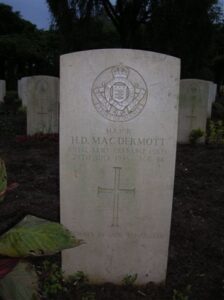
Alexander Cochrane Newton, Civilian. Alexander was born Underwood Cottage, in 1894, the son of John Alexander Newton and Phoebe Newton (nee Griffith). His father was a master mariner. Alexander joined his father in the Mercantile Marine at 14 years old, but following the outbreak of the Great War enlisted into the 12th Battalion, Gloucestershire Regiment. After two years as a soldier, he transferred into the Royal Flying Corps in 1916. He served throughout the war and after the Armistice went back to sea. By the time of the outbreak of WW2, he was still serving at sea and in April 1939 reportedly left Shanghai aboard a Chinese junk, bound for San Francisco. The junk stopped off in the Philippines, where Alexander remained, and he was taken prisoner following the Japanese invasion of the Philippines, which began on 8 December 1941. Alexander was interred at the University of Santo Tomas Internment Camp, but soon took ill and died of coronary thrombosis at St. Luke’s Hospital, Manila, Philippines on 28 April 1942, aged 48. He is buried in Manila. Alexander is not commemorated on the Laugharne War Memorial.
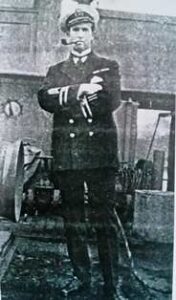
Francis Edward Hugh Owen, Able Seaman, C/SSX 15155, Royal Navy. Francis was born in Belfast on 27 September 1915, the son of Hugh and Edith Owen. The family moved to Laugharne soon after his birth. Francis enlisted into the Royal Navy and served as an Able Seaman aboard the submarine hunter and minesweeper HMS Huntley. The ship was in reserve at Singapore when war erupted and was despatched to the Mediterranean to hunt for German submarines. On 31 January 1941, HMS Huntley was attacked by German aircraft in the Eastern Mediterranean, and sank about 30 nautical miles West of Mersa Matruh, with the loss of eighteen lives. Francis was 25 years old when he was killed in the attack, and is commemorated on the Chatham Naval Memorial, Kent.
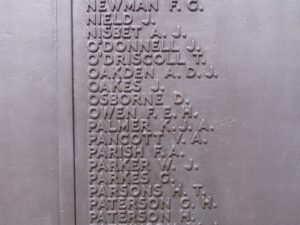
John Thomas Francis Owen, Able Seaman, J45239, Royal Navy. John, known as Francis, was born in Laugharne on 18 May 1899, the son of Thomas Owen and Mary Owen (nee Francis), of Clifton Street. John worked as a coachman prior to enlisting into the Royal Navy on 15 October 1915 and was posted to HMS Impregnable at Devonport for training. Over the coming years Francis served aboard a wide variety of ships, and continued to serve with the Royal Navy after the war. Francis married Winifred Maude Eden in Devon in 1931 and was still serving with the Royal Navy when the Second World War erupted. He served again throughout the duration of the war. Francis survived service in both World Wars, but died at Torbay Hospital, Torquay on 26 September 1946. Nothing further is known of him, as he is not commemorated by the CWGC.
Thomas Brian Owen, Sergeant, 1162333, Royal Air Force Volunteer Reserve. Thomas was born in 1919 in Laugharne, the son of William Owen and Annie Owen (nee Thomas), who were living in Carmarthen at the time of their son’s death. Thomas enlisted into the Royal Air Force Volunteer Reserve and was posted to No. 5 School of Technical Training at RAF Locking, in Somerset. Thomas continued to serve after the war but took ill and was taken to the RAF Hospital in St. Athan. He died there of tuberculosis on 30 May 1947. The body of the 26-year-old was brought back home to Laugharne and he was buried in the new graveyard at St. Martin’s church. He is not commemorated on the Laugharne war memorial.
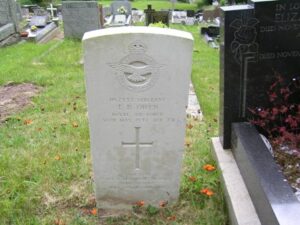
Austin Thomas Phillips, Leading Stoker, D/KX 91896, Royal Navy. Austin was born on 29 January 1918, the son of Richard Lewis Phillips and Mary Winifred Phillips of Brook Cottage, near Laugharne. Austin was a pupil of Brook School, before he went to Whitland Grammar School. After leaving school at 17 years old, Austin went to work at Great House Farm, Laugharne, before enlisting into the Royal Navy at 19 years old, on 17 August 1937. Austin was married to Margaret Winifred Phillips and they had a daughter Rose Mary Phillips. Training was thorough in the Royal Navy, and Austin spent time training at several Naval Bases including Drake and Tamar-before getting a posting on the ship HMS Glenearn on 12 December 1940. He was now a Stoker 1st Class. Glenearn was commandeered by the Royal Navy in October 1939 and converted into a Fast Fleet supply Ship. Her role was to supply fuel and ammunition to secret Atlantic Squadrons-tasked with the destruction of German surface ships in the Atlantic, but the withdrawal of the British Expeditionary Force from Dunkirk in 1940 meant that she was brought into service to aid in the evacuation of the besieged forces from the famous beaches. She was then converted to a Troopship-capable of carrying 1,090 troops, 12 small Landing Craft and two large Landing Craft. In April 1941 she was sent to Malta, along with her sister ship the Glengyle and on 19-20 April was used in the first ever Commando assault from specialised ships. On 22 April, while assisting in the evacuation of Greece, she received a direct hit on the focsle but remained operational, and on 26 April was hit twice more. She had to be towed to Crete by the destroyer HMS Griffin, and then to Alexandria. After the evacuation of 50,672 troops from Greece, she sailed through the Suez Canal, and was hit by a burning ship, and had to go to Colombo for repairs. In mid 1942 she returned to England and was fitted with davits to handle larger Landing Craft and was used in the Allied landings on D-Day on Sword Beach. In 1945, the Glenearn was sent to the Far East to join the Pacific Fleet, but in April was damaged by a fuel explosion while she was near the mouth of the Markham River, Papua New Guinea. Several crew members were badly wounded during the resulting fire, and were evacuated to Hospital at Hollandia, Papua New Guinea. On 15 April 1945, after being critically ill for several days, Austin died of burns. He was 27 years old. Austin was originally buried at Hollandia Hospital Cemetery, but after the War, the Graves from outlying cemeteries were brought into Lae War Cemetery, Papua New Guinea, as it was impossible to maintain the smaller outlying cemeteries.
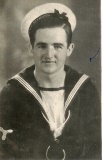
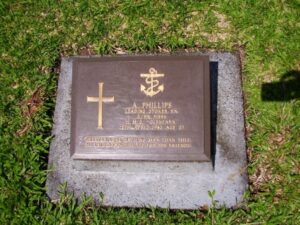
Frank David Thomas Phillips, Flight Sergeant, 1128364, Royal Air Force Volunteer Reserve. Frank was born in Laugharne around 1907, the son of John and Mary Anne Phillips of Laugharne (who resided in Carmarthen at the time of Franks’ death) and the cousin of Austin Thomas Phillips. He joined the Royal Air Force at the outbreak of war, becoming a Flight Sergeant in 35 Squadron, RAFVR, and trained as an Air Gunner-becoming a ‘Mid-Upper Gunner’. The Squadron was a bomber squadron, which in November 1940 was reformed for the purpose of introducing the new Handley-Page Halifax bombers into active service. The squadron was one of the groups that attempted to sink the Scharnhorst and Gneisenau during their escape dash from the North German Ports. In August 1942, 35 Squadron was incorporated into the elite ‘Pathfinder’ force, taking a major part in many bombing missions during the war, including the commando raids on Le Creusot and Peenemunde. In March 1944, the squadron converted to Lancaster’s, taking part in the D-Day bombing campaigns. On the night of 19/20 October 1944, Frank was part of an eight-man crew of the Lancaster Mark III serial no. TL J. Their mission was to bomb the German City of Stuttgart, which was deep behind the front lines. At 17:56 on 19 October 1944, Lancaster TL J took off from RAF Gravely. The raid was numbered ND755. The Lancaster had crossed the front Lines, and was almost into Germany, when it was brought down by enemy fire. The unfortunate crew were all killed in the resulting crash and are buried together at Wintzenbach Protestant Churchyard, Bas-Rhin, France.
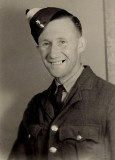
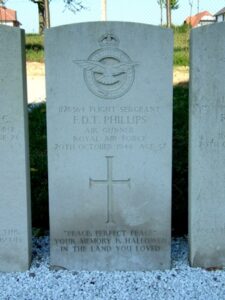
George David Roberts, Steward, Merchant Navy. George was born in 1912 in Mardy, Rhondda, the son of Frank Roberts of Laugharne. He joined the Merchant Navy on 26 March 1928 and served aboard several ships, before joining the crew of the SS Queen City on 23 February 1940. The Queen City was a cargo ship that had been built in 1924. It formed part of the Cardiff based fleet of the Reardon Smith Line Ltd. George’s papers show that he died of wounds received on 28 September 1940 aboard the SS Queen City, due to enemy action. The ship was 40 miles out of Hull when German Dive Bombers attacked it. George was aged 27, and is buried at the Rhondda (Ferndale) cemetery, in the family plot. George’s younger brother Jimmy Roberts was killed alongside George aboard the Queen City, but is not commemorated on the Laugharne War Memorial. The SS Queen City survived another 2 years at war, before being torpedoed and sank on 21 December 1942 off the coast of Paraguay.
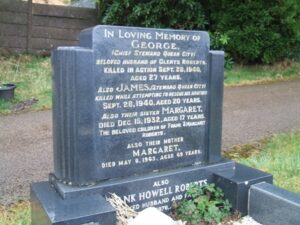
James Frederick Roberts, Steward, Merchant Navy. James was the son of Frank Roberts, of Laugharne, and lived at Mardy with the family prior to the war. He served with his brother George aboard the SS Queen City, a cargo ship that had been built in 1924. It formed part of the Cardiff based fleet of the Reardon Smith Line Ltd. On 28 September 1940 Queen City was 40 miles out of Hull when she was attacked by German Stuka Dive Bombers, and sustained heavy damage. James was killed while attempting to save his brother George, who was also killed in the attack. James was just 20 years old, and is buried in a joint grave with George, at Rhondda (Ferndale) Cemetery. For some reason, James is not commemorated alongside his brother at Laugharne.

Thomas Essery Rose-Richards, Sub-Lieutenant, Fleet Air Arm. Tim was born in Swansea on 6 June 1902. His father Major Thomas Picton Rose-Richards, had served throughout the Great War, and had become a Mid-War MP for Breconshire, before retiring, and moving to Island House, in Laugharne. Tim was a well known racing driver. He had entered Le Mans five times, finishing in 3rd place in 1931, 1932 and 1933. He also raced in Grand Prix, finishing fourth in the 1934 Dieppe GP with a Bugatti T51, and third in the 1935 Eifel Voiturette GP driving ERA R1A. Tim won a coveted BRDC Gold Star in 1935, and this resulted in him being remembered in the BRDC Hall of Fame, at the famous Brooklands. When War broke out, Tim volunteered into the Royal Navy. From the Navy, he became a Flight Lieutenant in the Fleet Air Arm, serving at HMS Daedalus on the South Coast, with 765 Squadron. The Squadron flew the Supermarine Walrus. This was a single-engined ‘flying-boat’, which was used as a search and rescue and reconnaissance aeroplane. On 7 October 1940, during the Battle of Britain, a German Bomber was forced down in the English Channel. Thomas and his aircrew were sent to rescue the downed crew, in their Supermarine Walrus. As they came down to prepare for landing, their aircraft was raked by machine-gun fire from a German Heinkel, which sent them spinning into the sea. Thomas was reported mission 7-8 miles south of Anvil Point. None of the bodies were recovered, and so Tim is commemorated on the walls of the Lee-On-Solent Memorial, Hampshire. Tim is not commemorated at Laugharne.
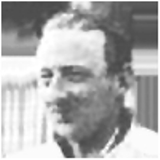
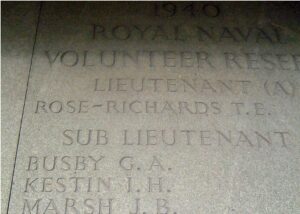
Bridgeman Rochfort Mordaunt Smith, Lieutenant, Royal Naval Volunteer Reserve. Bridgeman was born on 15 June 1899, the son of Mordaunt Kirwan Smith, and Blanche Mordaunt-Smith, of Laugharne. He married Elsie Waller-Bridge, of Copthorne, Essex, in 1938. His older brother Lionel was killed in the Great War, serving with the Inniskilling Fusiliers. Bridgeman also served in the Great War, firstly with the Mercantile Marine and then as a Midshipman in the Royal Navy. He was aboard HMS Colossus in the Battle of Jutland, when the Colossus was hit by German shellfire and damaged. He was home in Laugharne on leave shortly afterwards, before returning to sea and finishing the war off unscathed. After the Great War, Bridgeman was commissioned into the Royal Indian Navy, where he served as Sub-Lieutenant until resigning his Commission in 1922. Later that year he was commissioned into the Royal Warwickshire Regiment as Second Lieutenant, resigning his commission there in September 1926, due to Bankruptcy proceedings due to a failed business venture. At the outbreak of the Second War, Bridgeman was commissioned as Temporary Lieutenant in the Royal Naval Volunteer Reserve on 16 November 1939. From 10 January 1940, he served at HMS Elfin, a submarine base in Blyth, then from 7 January 1941 at HMS Flora, a Royal Naval base at Invergordon, for miscellaneous services. Bridgeman is recorded with the Commonwealth War Graves Commission as being killed in action on 6 September 1943, but the details of his death are a bit sketchy, as his Death Certificate shows that he died at home in Warwick of Heart Failure at the age of 44. He is buried in the Mordaunt-Smith Family plot in St. Martins, Churchyard Laugharne, but is not commemorated on the memorial.
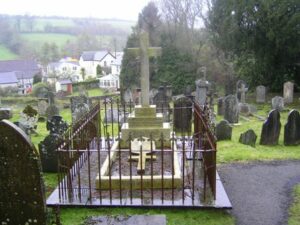
Ivor Morgan Thomas, Sub-Lieutenant, Royal Naval Reserve. Ivor was born in Laugharne in 1920, to Albert William and Sarah Dora Thomas (nee Harries). He joined the Royal Naval Volunteer Reserve at the outbreak of war, and was transferred to the submarine service as a Sub Lieutenant aboard a top secret experimental craft, the submarine X-4. She was designed and built early in WW2 for the express purpose of attacking enemy warships moored in protected anchorages, in particular the German battleship ‘Tirpitz’ which was moored in a protected anchorage in Norway. Before moving to Scotland for his training on the Submarine, Ivor married Josephine Thomas in London. Four craft, the X-1 to X-4 were built in utmost secrecy, and sent to Loch Striven in Scotland for sea trials. The training was rugged and thorough, with the crews trained in every facet of an operation, such as cutting through anti-submarine nets and escape and evasion. The crew were also subjected to depth charge attacks to familiarise themselves with the fearful experience. Two men lost their lives through accident during training. The first of these was Ivor. On 11 December 1942, X-4 was caught in a storm while on an exercise on the Loch. Ivor opened the rear hatch to ditch some garbage, when X-4 was swamped by a wave, sweeping Ivor to his death. The submarine began flooding, but after two hours battling to stay afloat, X-4 was towed back to safety. Ivor’s body was never found, and he is commemorated on the Portsmouth Naval Memorial, Devon. Ivor could have been the second man from Laugharne to gain the award of the Victoria Cross, after William Fuller, who gained his in 1914. The fellow crewmen of Ivor Morgan Thomas went on to mount a successful mission to inflict damage to the Battleship Tirpitz, which put her out of action for practically the rest of the war. Two men were awarded the coveted Victoria Cross for the action; one of whom was Ivor’s compatriot from the X-4, Lieutenant Godfrey Place.
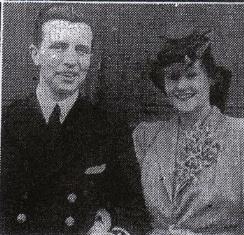
Gordon Thomas Garfield Williams, Aircraftman 2nd Class, 932450, Royal Air Force Volunteer Reserve. Gordon was born at Llanstadwell, the son of Thomas Stanley Garfield and Annie Jane Williams. He married Edna Mary Roberts at St. Martin’s Church, Laugharne on 17 August 1936, who was the aunt of Cyril Roberts, a well known man in Laugharne. Gordon was the Head Gardener at Amroth Castle before the war, but had moved back to Cardiff with his wife and their two children, where he enlisted into the Royal Air Force. Gordon was transferred overseas with the Royal Air Force, and was stationed in Malaya at the early part of the war. Simultaneously with their attack on Pearl Harbour, Hawaii, on 7 December 1941, the Japanese landed at Kota Bharu, Malaya, and also crossed the border into Mainland Hong Kong. Hong Kong fell on 25 December 1941 when 100 RAF men were captured. As the Japanese advanced down Malaya, one by one, the twenty-two airfields in Malaya were evacuated and by 16 January 1942 all Air Force Squadrons, Units and Station Staff had been driven back to Singapore Island. A few RAF men did manage to board the few boats and reach Australia safely, but approximately 4,600 men went into captivity. About 100 men of the RAF and the various Commonwealth Air Forces were captured after being shot down in Burma. Less than 30 were shot down elsewhere. Little is known of how Gordon met his fate, but he died on 6 March 1942, aged 33, and is remembered on the Singapore Memorial, Kranji.
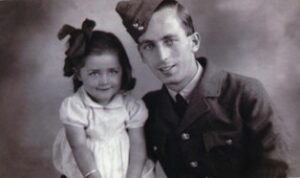
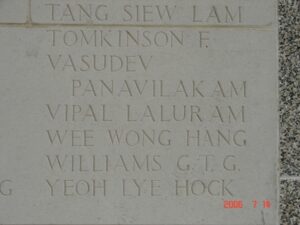
Post WW2
William Howell Morse, Lieutenant, Royal Navy. William was born at New Mill, Laugharne on 18 January 1931, the son of William Twin Morse and Sarah Ann Morse (nee Howells). He was educated at Whitland Grammar School, and after leaving in 1946, passed his entrance exam for the Royal Navy. He originally joined as an Artificers Apprentice and passed out four years later as a Petty Officer. The Royal Navy was looking to recruit pilots at the time, so William applied, and was accepted. After undertaking further officer training, William undertook flying training at RAF Lossiemouth in Scotland. He then successfully passed his jet conversion training before joining 800 Squadron, Fleet Air Arm at Brawdy in March 1955. After six months at Brawdy, during which time William flew over New Mill several times, the Squadron was posted to HMS Ark Royal for her maiden voyage to the Mediterranean. On 14 October 1955 Ark Royal passed through the Straits of Gibraltar. William was the first man to take off that day, but the catapult failed, and without the extra boost in speed to get airborne, Williams’ aircraft plunged off the deck into the sea. The ship was stopped and a search was carried out, but there was no trace of William nor his aircraft. William was 24 years old when he died that day, and is commemorated on the Armed Forces Memorial at Alrewas, Staffordshire. Many thanks to Walter Morse for sending in the information about his brother William.
